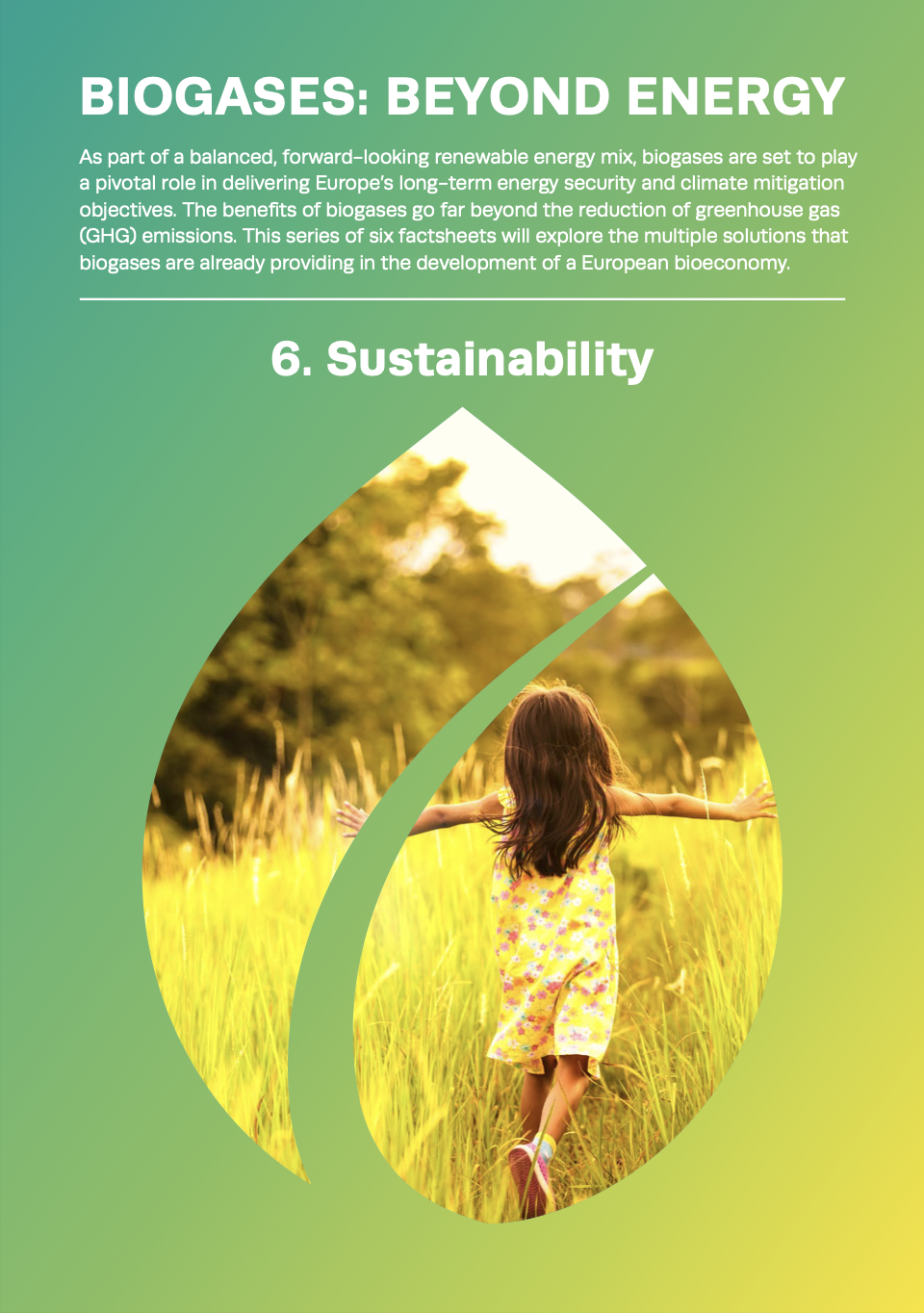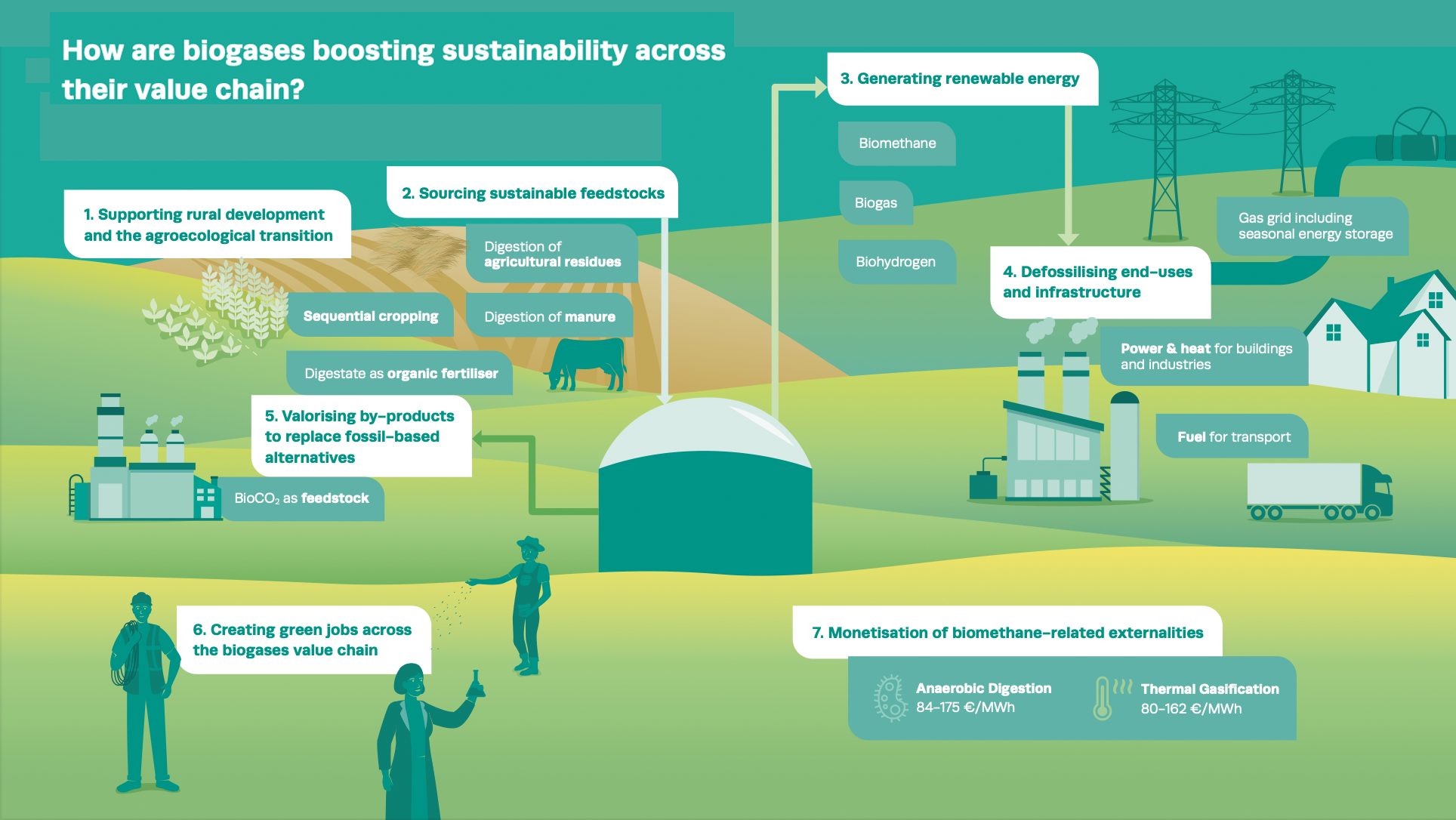Biogases will play a pivotal role in delivering Europe’s long-term energy security and climate mitigation objectives, as part of a forward-looking and balanced renewable energy mix. Besides, their benefits go far beyond the reduction of greenhouse gas (GHG) emissions. That is why attention to this source of renewable energy and scientific developments regarding biogas is increasing.

A series of six fact sheets explores the various solutions that different types of biogas already offer for the development of the European bioeconomy.
We are glad to announce that the last sixth factsheet “Sustainability” of the European Biogas Association (EBA) information campaign “Biogases: beyond energy” has already been published. The document is focused on the role that biomethane plays in meeting industrial needs.
You can get acquainted with the previous factsheets: «Energy system integration», «Regenerative agriculture», «Transport», «Heating», а також «Industrial uses».
Biogases’ sustainability
Sustainability ensures our well-being while respecting our environment and that of future generations: it underpins the further development of biogases in Europe. The production and use of biogases in the EU must comply with a set of sustainability criteria that came into force in 2018. These criteria ensure that sourcing feedstock does not negatively impact on biodiversity and the environment, biogases are used in an efficient fashion, and greenhouse gas (GHG) emissions are substantially reduced, relative to the use of fossil fuels.
Over the past decade, significant steps have been taken to preserve our natural environment. The 2030 Agenda for Sustainable Development outlines 17 sustainable development goals (SDGs); the achievement of many of these can be supported via the production and use of biogases.
How are biogases boosting sustainability across their value chain?
- Supporting rural development and the agroecological transition
- Sourcing sustainable feedstocks: digestion of agricultural residues (sequential cropping), digestion of manure (digestate as organic fertiliser)
- Generating renewable energy: biomethane, biogas, biohydrogen
- Defossilising end-uses and infrastructure (gas grid including seasonal energy storage; power & heat for buildings and industries; fuel for transport)
- Valorising by-products to replace fossil-based alternatives (BioCO2 as feedstock)
- Creating green jobs across the biogases value chain
- Monetisation of biomethane-related externalities (anaerobic digestion — 84-175 €/MWh; thermal gasification — 80-162 €/MWh)

Facts
How can biogases support sustainable economic growth?
Biogases contribute directly to 12 of the 17 SDGs, thanks to their ability to increase the share of renewable energy, reduce climate change effects, enhance waste management and create sustainable jobs. The recent Guidehouse study, Monetising biomethane’s whole system benefits (2022), concludes that by 2030, the socio-economic and environmental benefits of biomethane production to the EU27 and the UK will range from €38-78 billion per year, with the potential to reach €283 billion by 2050.
How are biogases contributing to GHG savings?
Biogases have the unique ability to remove carbon from circulation and thus be carbon negative: the biogases value chain starts with the extraction of carbon dioxide (CO2) from the atmosphere via photosynthesis. Further contributions to GHG savings along the biogases value chain include avoiding methane emissions; replacing the energy-intensive production of synthetic fertlisers; building soil organic carbon via the application of digestate and the introduction of new agricultural practices; replacing fossil CO2 in chemical usage; permanently removing CO2 from the atmosphere by carbon capture and storage; and replacing fossil fuels, as well as supporting the development of other renewables by facilitating energy system integration.
How can plant design and mitigation help to reduce methane emissions?
Biodegradable waste is widespread and originates from many different societal and economic activities. Examples include food waste, agricultural by-products, and sewage sludge. If left untreated, these and other waste products generate an uncontrolled release of methane. Anaerobic Digestion (AD) plants are controlled environments where these emissions are turned into renewable gas. Although AD-related methane emissions do occur, the biogases industry is a net reducer of methane emissions. Thanks to successful monitoring programmes and technical advancements, actual methane emissions are kept to a minimum.
What are the RED sustainability criteria and why are they so important for the sector?
In 2018, the Renewable Energy Directive (RED) introduced a set of sustainability and GHG emissions savings criteria for biogases. These requirements ensure that biogases are produced using sustainably sourced feedstocks, soil health is safeguarded, and significant GHG emissions savings are made relative to the use of fossil fuels.
Our sector must comply with these requirements, in order to:
- count towards the EU overall renewable energy target and sectoral sub-targets;
- be eligible for public support;
- achieve a zero-rating in the EU emissions trading system and be considered as a valid GHG emissions mitigation option.
The RED policy has had a positive impact on the quality of feedstocks used for biogases. The data show that, since the regulations were introduced, new biomethane plants have increasingly looked to waste- and residues-based feedstocks for their operations.
Read more about the information campaign at the link.
Download the first factsheet “Energy system integration” here.
Download the second factsheet “About regenerative agriculture” here.
Download the third factsheet “Transport” here.
Download the fourth factsheet “Heating” here.
Download the fifth factsheet “Industry” here.
Download the sixth factsheet “Sustainability” here.